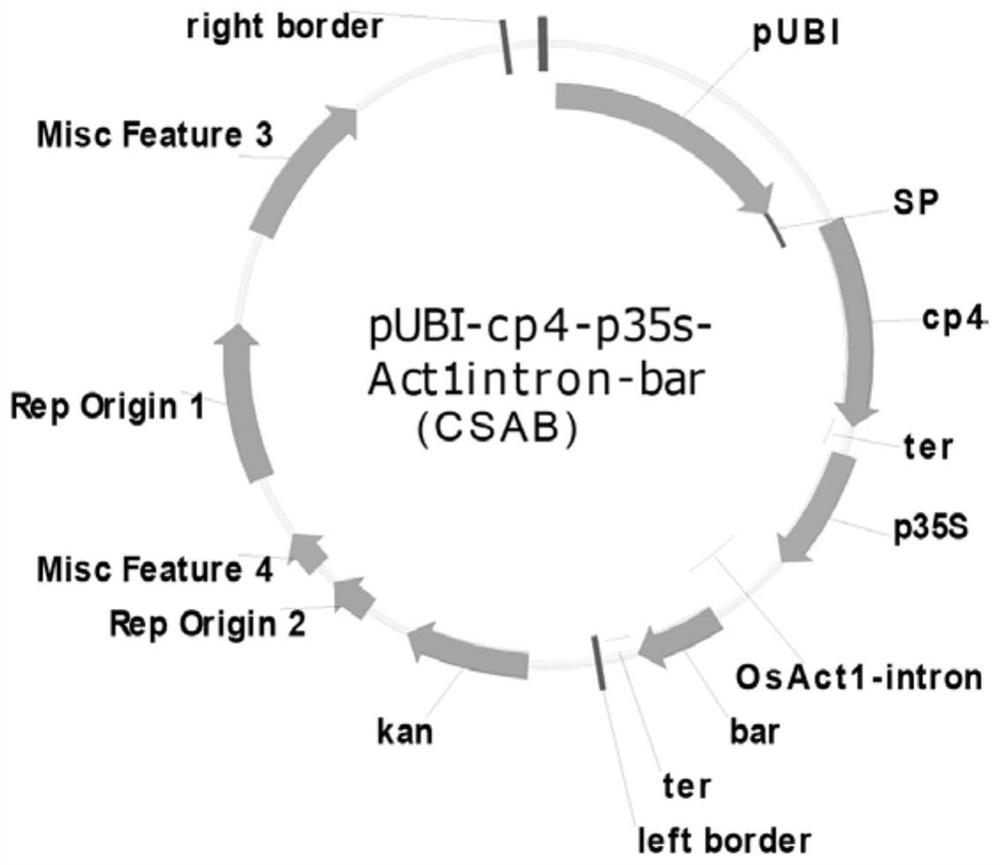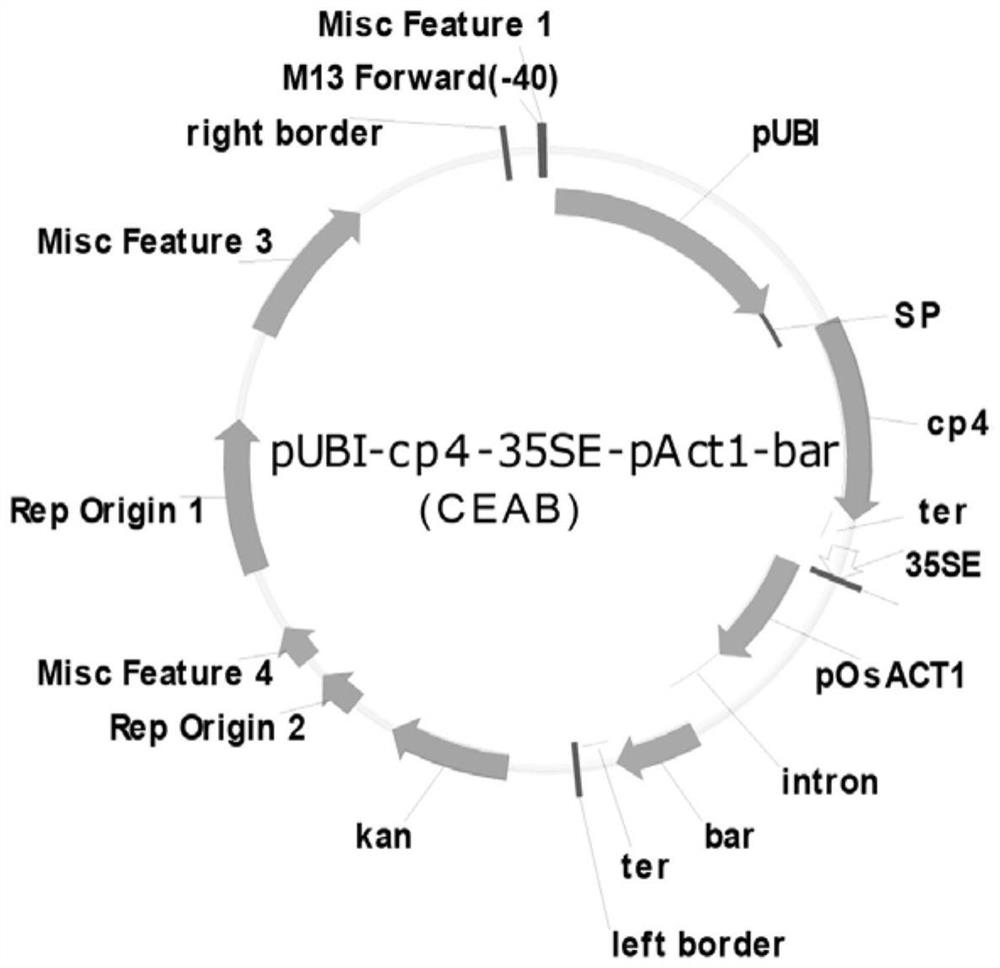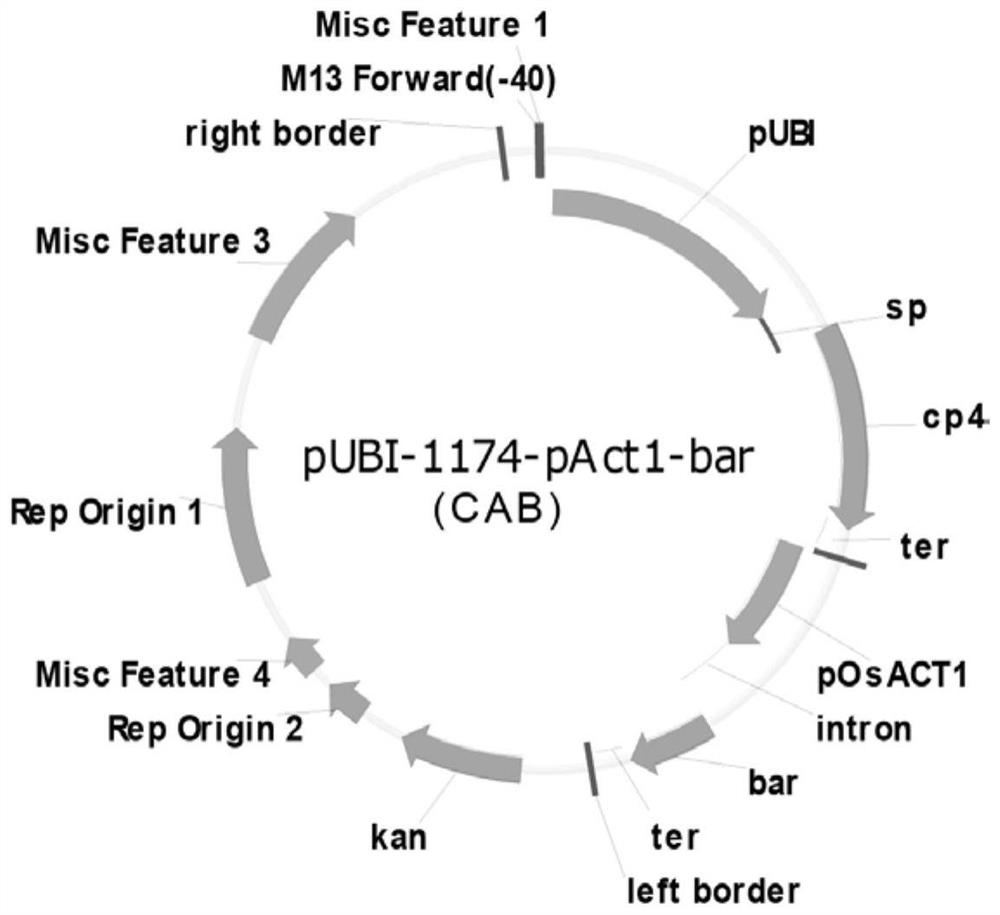Herbicide resistance gene expression vector and application thereof
A technology for expressing vectors and resistance genes, which can be used in applications, genetic engineering, plant genetic improvement, etc., and can solve the problems of uncertain traits, uncertain safety evaluation of expressed proteins, and low expression levels
- Summary
- Abstract
- Description
- Claims
- Application Information
AI Technical Summary
Problems solved by technology
Method used
Image
Examples
Embodiment 1
[0039] Embodiment 1, the construction of carrier
[0040] In order to construct the three vectors involved in the present invention, the p35S-OsAct1 intron composite promoter (shown in 4069bp-5393bp in SEQ ID NO: 1), the glufosinate-ammonium resistance gene bar (shown in 5401bp in SEQ ID NO: 1) were artificially synthesized respectively. -5955bp), pUBi-CP4-ter (274bp-4073bp in SEQ ID NO: 1), 35SE-pOsAct1 promoter (SEQ ID NO: 2) and the promoter pOsAct1 of rice Act1 gene (218bp in SEQ ID NO: 2 -1586bp).
[0041] (1) Construction of CSAB carrier: figure 1 , in order to obtain high expression cp4 and bar gene expression vector simultaneously, carry out double enzyme digestion to vector pCambia1300 (purchased from VWR company) with XhoI and KpnI, reclaim and obtain vector pCambia1300; NO: the plasmid of 5401bp-5955bp) in 1, obtain the bar fragment; use NcoI and KpnI to the plasmid containing the artificially synthesized p35S-OsAct1 intron composite promoter (shown in 4069bp-5393...
Embodiment 2
[0045] Embodiment 2, transformation of rice
[0046] The method of obtaining transgenic rice is to adopt the existing technology (Lu Xiongbin, Gong Zuxun (1998) Life Science 10: 125-131; Liu Fan et al. (2003) Molecular Plant Breeding 1: 108-115). The mature and plump seeds of "Xiushui-134" were dehulled, and callus was induced as transformation materials. The Agrobacterium plates of the vectors CSAB, CEAB and CAB constructed in Example 1 were taken respectively. Pick a single colony to inoculate and prepare Agrobacterium for transformation. The callus tissue to be transformed is put into OD and be 0.6 Agrobacterium bacterium liquid (preparation of Agrobacterium bacterium liquid: inoculate Agrobacterium to culture medium, be cultivated to OD be 0.6; Medium composition: 3g / L K 2 HPO 4 , 1g / LNaH 2 PO 4 , 1g / LNH 4 Cl, 0.3g / L MgSO 4 ·7H 2 O, 0.15g / L KCl, 0.01g / L CaCl 2 , 0.0025g / LFeSO 4 ·7H 20, 5g / L sucrose, 20mg / L acetosyringone, the solvent is water, pH=5.8), allow Agr...
Embodiment 3
[0047] Examination of bar and cp4 gene expression levels in embodiment 3, transgenic rice
[0048] 1. PAT / bar protein extraction and ELISA analysis
[0049] The method of checking the bar gene expression in transgenic plants: take 0.1g leaves, cut into pieces, add 1-1.5ml 1×PBS, add to the homogenizer and grind, then strictly follow the PAT / bar transgene detection kit (AS013LSEnviroLogix ) instructions can be operated.
[0050] Specifically, the sample extract was diluted 500 times with 1×PBS. The same tissue extracts from non-transgenic rice plants containing the same dilution multiples were used as a control to detect the background signal produced by the test tissue. BAR standards containing known concentrations produced by microorganisms (Li Congcong et al. 2015. Hubei Agricultural Science, 000 (010), 2516-2518) were used to generate a standard curve (the curve equation is Y=0.228X-1.638). Each plate contains a blank buffer to detect background signal from the extractio...
PUM
 Login to View More
Login to View More Abstract
Description
Claims
Application Information
 Login to View More
Login to View More - R&D
- Intellectual Property
- Life Sciences
- Materials
- Tech Scout
- Unparalleled Data Quality
- Higher Quality Content
- 60% Fewer Hallucinations
Browse by: Latest US Patents, China's latest patents, Technical Efficacy Thesaurus, Application Domain, Technology Topic, Popular Technical Reports.
© 2025 PatSnap. All rights reserved.Legal|Privacy policy|Modern Slavery Act Transparency Statement|Sitemap|About US| Contact US: help@patsnap.com



